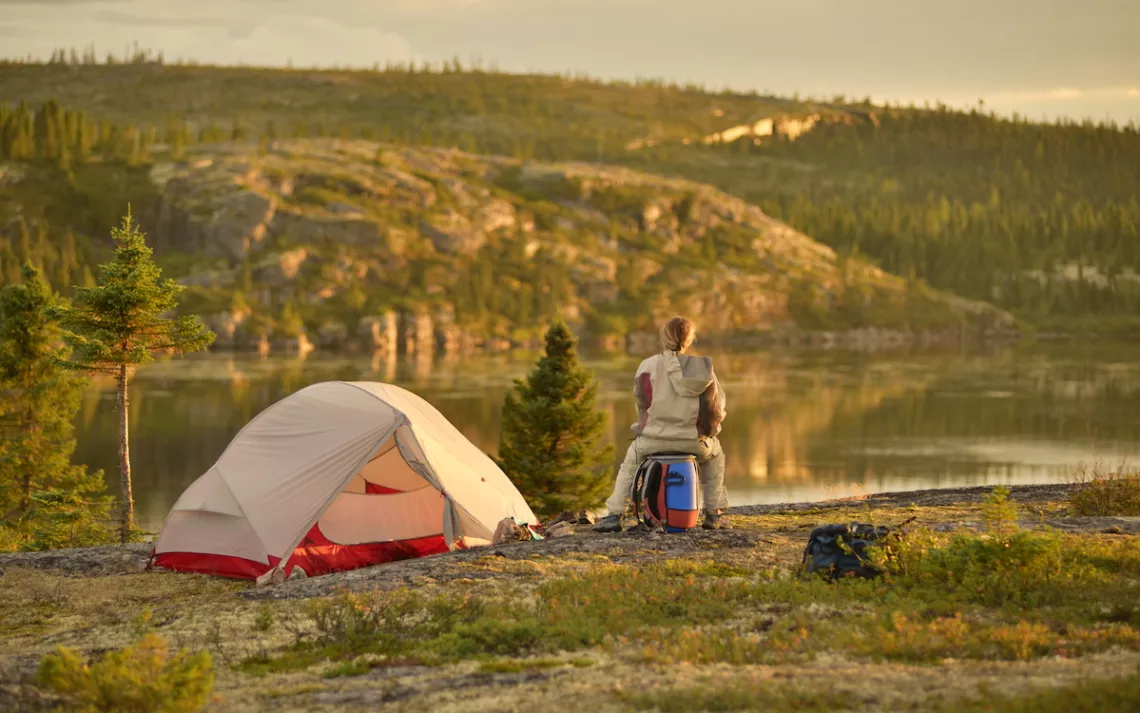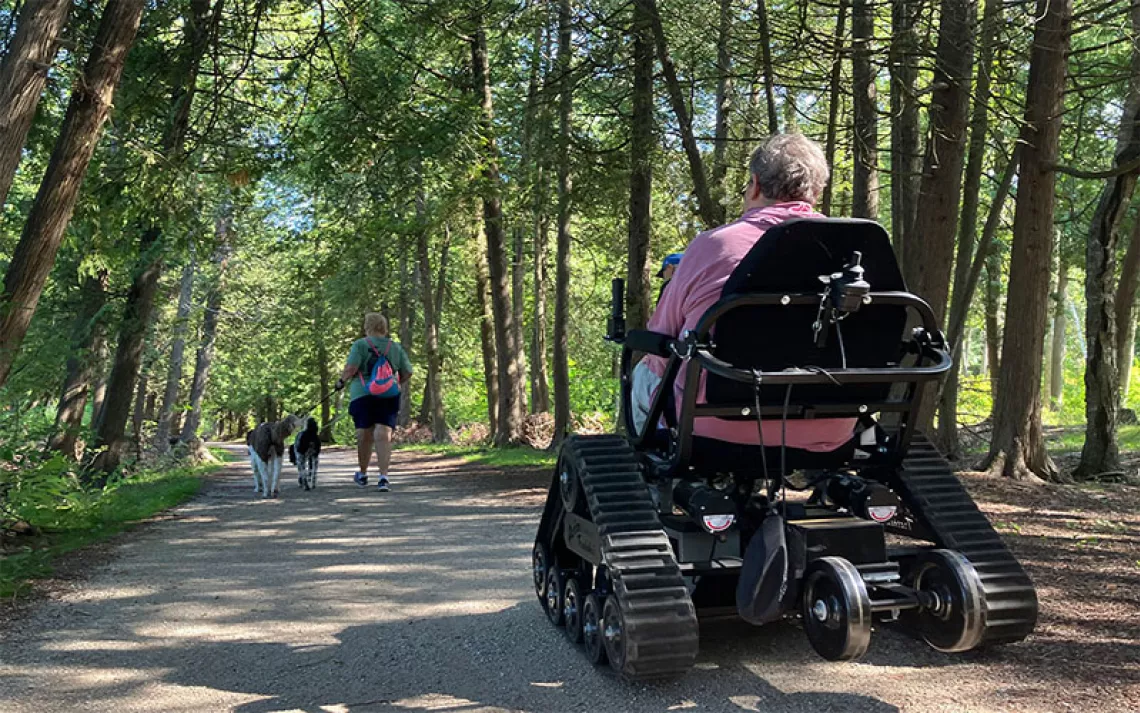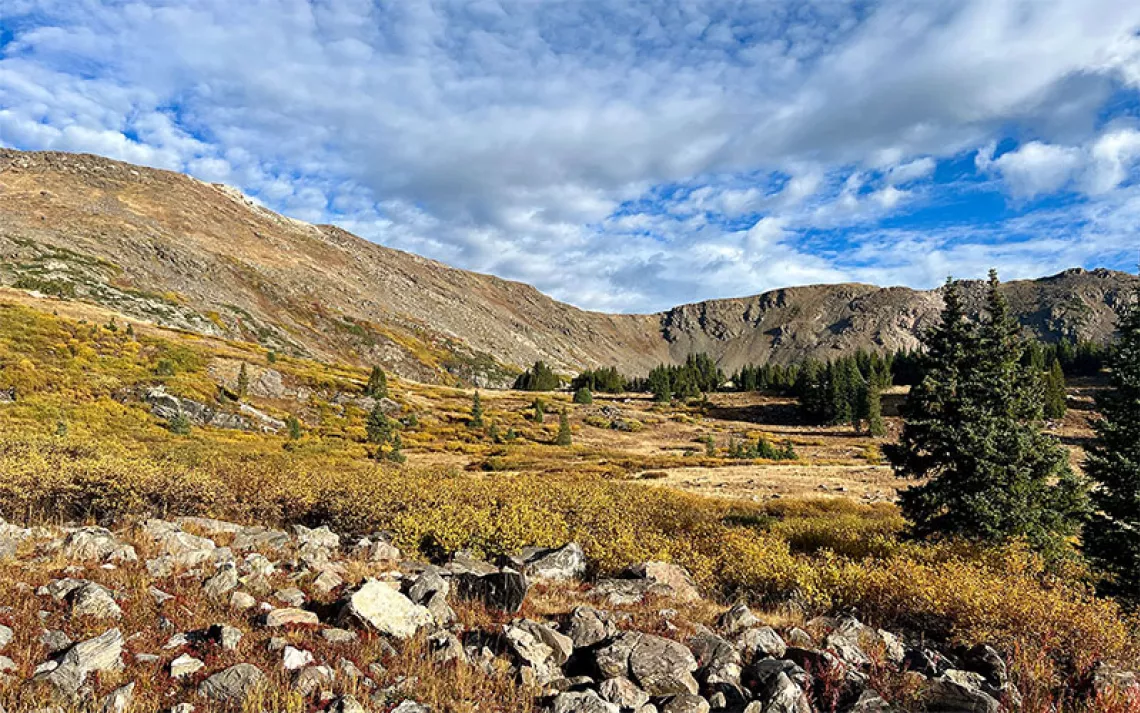Welcome to the Slackcountry
Popular campsites all taken, but you aren’t up for the rigors of the backcountry? This is the place for you.

Photo by Conor Mihell
I was thrilled when my littlest sister started making weekend camping trips during the COVID-19 pandemic. I had previously tried to share my love of backcountry trips with her, with modest success. But when the stress of the pandemic became too much, Cameron and her partner, Colton, both 24, suddenly came to appreciate the “freedom of the hills.”
They weren’t alone: Across North America, camping and outdoor recreation have surged in popularity since 2020. A survey of national parks in the western United States reported an overall 20 percent spike in visitation, while Canada saw similar numbers, with my home province of Ontario reporting a whopping 140 percent increase in provincial park campground bookings in 2021 over already high 2020 levels. New camping enthusiasts like my sister even had to compete with those looking to turn a profit by reselling park permits.
Faced by a dearth of vacancies in developed campgrounds, Cameron and Colton started seeking out the “slackcountry.” They explored places beyond the roads, looking for quieter, primitive campsites that sometimes required hiking a mile or two beyond trailhead parking lots to get there. In the process, they also discovered the delights of public lands (“Crown” lands if you’re in Canada) for low-impact, DIY outdoor recreation.
Here are some tips on how to make your own way from frontcountry to slackcountry.
Where to go: Steering clear of iconic places has always been the best way to discover hidden gems. That means checking out smaller state parks, many of which include little-known options for backcountry camping within a short hike of established trailheads. Ask around, as backcountry campsites are often poorly advertised. Similarly, US Forest Service and Bureau of Land Management public lands often provide areas for primitive camping. You can research access points around long-distance hiking trails like the North Country Trail and Appalachian Trail; odds are you’ll find places to camp within a short walk.
Pack it in: Getting beyond the roads means carrying gear on your back. That makes it imperative to pare down to the essentials (without neglecting safety items like warm clothing layers and a first aid kit). The best way to get it right is to keep a list and, after each outing, note what you used and what you didn’t to streamline your packing list for future trips. Speaking of packs, you could do worse than to borrow or buy an internal-frame backpack like the Sierra Designs Gigawatt 60L ($119.95, sierradesigns.com), a full-featured, budget-friendly pack with over 3,600 cubic inches of storage space and an adjustable harness.
Camp in comfort: Long-distance backpackers go to great lengths to save on weight, like sleeping under gossamer-thin tarps and using minimalist sleeping bags. You don’t have to do that on weekend trips when you’re not traveling far, but you can benefit from new technology. Modern tents are spacious and light, which allows you to upsize (that is, choosing a four-person model if you’re a group of three) for more elbow room. Check out the Big Agnes Spicer Peak 4 ($449.95, bigagnes.com), a 58-square-foot dome that features near-vertical walls for greater usable space and a packed weight of under nine pounds. Or, for an ultralight shelter that will encourage you to venture deeper into the backcountry, look at the Sea to Summit Telos TR3 ($659, seatosummit.com), a three-person (i.e., two people comfortably) that has multiple setup arrangements for outstanding views and ventilation.
You’ll find a similar comfort-to-weight spectrum in sleeping pads. Worried about sore hips? Go big with the aptly named Thermarest MondoKing 3D ($229.95–$259.95, thermarest.com), a 4.25-inch-thick, self-inflating pad that rivals your pocket spring mattress at home (though it rolls into a reasonably compact cylinder, you’ll likely have to strap it to your backpack). Couples might consider a two-person mattress like the Exped Dura 5R Duo ($249.95, expedusa.com), which, besides being cushy, saves packing two mattresses and is made from recycled materials. Finally, down remains the gold standard in sleeping bag insulation, especially with most manufacturers offering water-resistant and third-party-certified responsibly sourced materials. The Big Agnes 3N1 ($329.95–$419.95, bigagnes.com) lineup of gender-specific bags, for example, offers comfort for trips from spring through autumn in a wide range of temperatures.
Camp kitchen: With few exceptions, prepackaged, freeze-dried backcountry meals are expensive, skimpy, and laden with salt. Think about ways you can modify your favorite recipes for the backcountry: pastas, rice dishes, and legume-based meals all transfer well to outdoor cooking. You’ll find powdered pesto, dehydrated scalloped potatoes, and foil-packed chicken in every supermarket. For breakfast, oatmeal is greatly improved by toppings like dried fruit, seeds, and nuts. Flatbread, bagels, cheese, and peanut butter are standbys for lunch. Many fresh fruits and vegetables (apples, oranges, citrus, and root veggies like carrots) keep for days. If you’re going to get out a lot, investing in a food dehydrator pays quick dividends and gives you fun projects to work on over the winter; basic models from Nesco start at $50 (nesco.com), or splurge on a higher-end Excalibur (starting at $149.99, excaliburdehydrator.com).
When it’s time to cook, a liquid fuel (a.k.a. white gas) stove like the classic MSR Whisperlite Universal ($169.95, msrgear.com) is more efficient and produces less waste than a canister stove. You can save pack space with collapsible silicone Sea to Summit X-Set cookware, including a pot, bowls, and mugs (starting at $74.95, seatosummit.com). Gathering water from creeks, rivers, and lakes and boiling it for five minutes is a reliable but tedious way to produce clean drinking water; a microfilter like the Platypus QuickDraw ($44.95, platy.com) weighs only 3.3 ounces and uses a squeeze system to produce up to three liters of pure, taste- and pathogen-free water.
Stay safe: As with any outdoor adventure, leave an itinerary with a loved one, including a plan of action for what to do if you don’t check back in by the expected date and when to do it. Getting beyond the range of cell phone networks is liberating, but a lack of communication also exposes you to greater risk. Consider investing in (or renting) a satellite communication device such as a SPOT X ($249.99 plus service plan, findmespot.com), which allows two-way text messaging, mapping, and the ability to trigger search and rescue services if necessary.
Pack it out: The first objective of wilderness travelers should always be to do no harm to the environment. That means taking responsibility for your actions and thinking critically about how your actions will impact the surroundings, considering everything from where you pitch your tent to whether or not you choose to light a campfire, as well as your impact on wildlife and other human visitors—not to mention how you deal with your dishwater and bodily waste. Low-impact camping guidelines vary depending on climate, landscape characteristics, and remoteness. Main priorities wherever you go include traveling and camping on durable surfaces to avoid trampling vegetation, minimizing the use of fire, keeping quiet, safely securing foods to minimize smells, giving wildlife plenty of space, and disposing of dishwater and human waste in shallow-dug (and reburied) catholes, at least 200 feet from open water. Learn more about specific guidelines at Leave No Trace.
Learn more and get inspired: Sierra Club Outings are a great way to meet fellow adventurers, learn skills (and often contribute to good causes), and discover new environments. A variety of outings are available across North America and the world for all types of travelers, including wilderness-restoration projects and budget-friendly offerings for young adults.
 The Magazine of The Sierra Club
The Magazine of The Sierra Club






